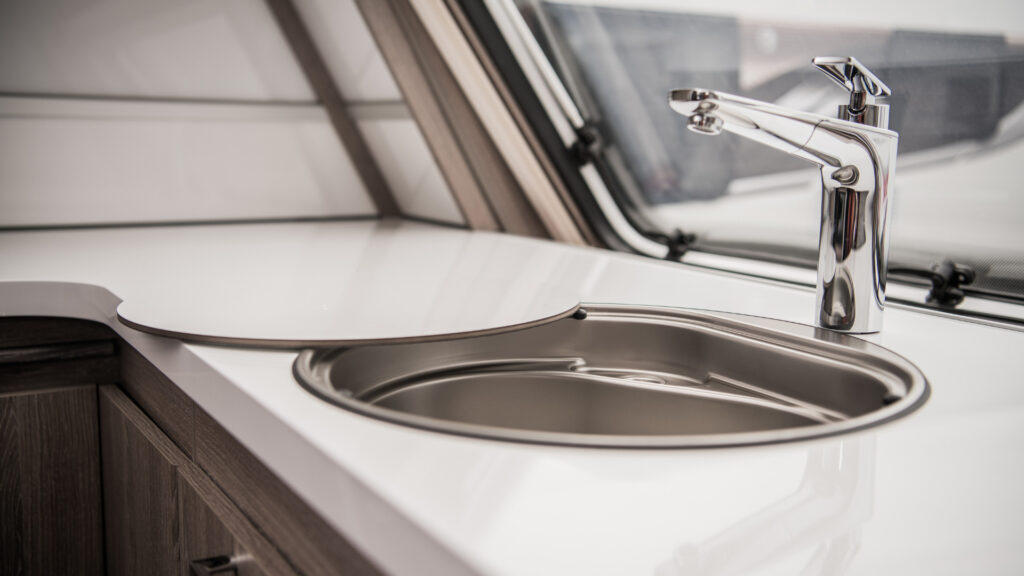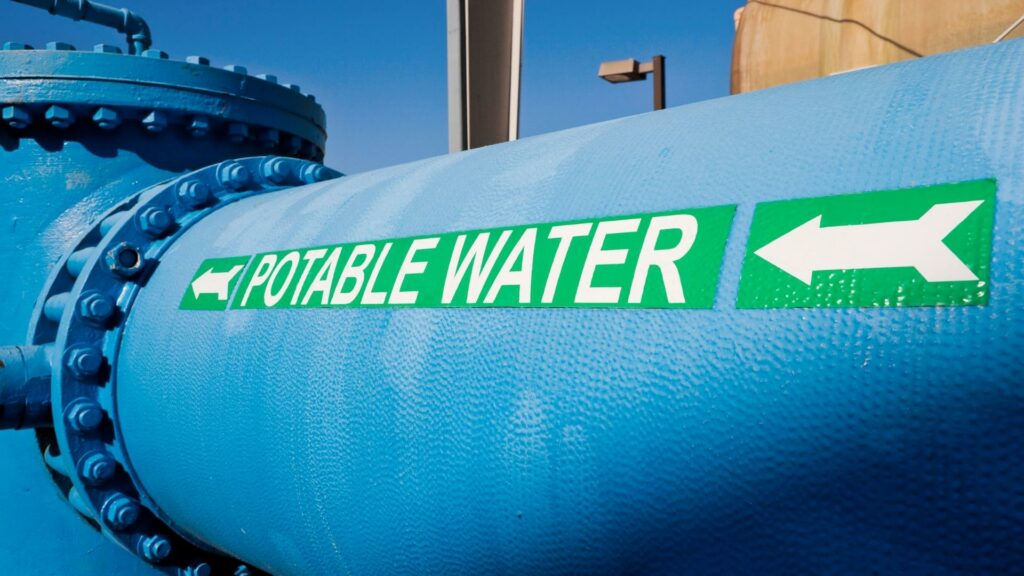Table of Contents Show
If you enjoy camping in your RV outside of a traditional campground, you’ll often need to bring water with you. However, traveling with a full water tank is a frequently debated topic in the RV community.
Some swear you should never do it, and others do it religiously. So is it safe to drive an RV with a full water tank?
Today, we’re looking at whether it’s a good idea or not to travel with a full water tank during your adventures. Let’s get to the bottom of this!
What Is an RV Freshwater Tank?
An RV fresh water tank is the storage tank for clean, potable water used in an RV.
This is the water used in all the faucets, toilets, and showers. An RV’s plumbing system typically uses a water pump to transport water from the freshwater tank to the open faucet.
These tanks allow RVers to boondock or camp away from a water source in dry camping locations.
They can take a large amount of water to their remote campsite and still use showers, toilets, and faucets. Freshwater tanks allow RVers to be self-sufficient and extend the time they can spend traveling.
Pro Tip: If you want to learn more about fresh water tanks and how they work, read What Is an RV Fresh Water Tank?
How Big Are RV Freshwater Tanks?
While practically every RV comes with a freshwater tank, they’re not all the same size. These tanks typically range from 20 to 100 gallons, depending on the RV.
Smaller travel trailers and motorhomes typically have smaller tanks. Meanwhile, larger toy haulers and Class A motorhomes will have massively large tanks.
Naturally, the larger the fresh water tank, the longer RVers can spend adventuring. Having too small of a tank means having to either pack up your stuff to find water or have a way to transport the water to your RV.
If you plan to spend a tremendous amount of time outside of established campgrounds, you’ll want a larger freshwater tank.
Pro Tip: You might wonder Can You Dump Gray Water on the Ground When Dispersed Camping? Click the link to find out!

How Heavy Is a Full Water Tank?
A gallon of water weighs around 8 pounds. This means that the smallest RV tanks will add about 150 to 175 pounds to the total weight of your RV.
While this might not sound like much, 50 to 100-gallon tanks would add 400 to 800 pounds when full. That’s quite a bit of weight!
It’s important to factor in the weight of your freshwater tanks as RVs can only hold a certain amount of weight.
Exceeding the cargo carrying capacity of your RV can damage the suspension and increase the wear and tear on your rig. Overloading an RV is one of the biggest causes of tire blowouts.
That can cause thousands of dollars in damage to a rig and leave the owners stranded.
Keep in Mind: Need to replace your RV water tank? Here are some of the best places to Buy Replacement RV Water Tanks!
When Would You Have a Full Water Tank?
You’re typically only going to have a full water tank when there is no water supply at the campsite. This could be a rustic campsite, a remote boondocking site on public lands, or when you take your RV to an event.
These camping options will require campers to bring enough water to last for the duration of their stay.
You’ll need to manage your water usage in many of these instances. Running out of water can be extremely inconvenient, and getting more can be tricky.
However, it’s not impossible, and some RVers can go weeks before they need to pack up their things. RVers often find it’s easier to get more water than to dump the contents of their black tanks.
This is often the limiting factor for those wanting to enjoy time away boondocking or dry camping.

Is It Safe to Drive an RV With a Full Water Tank?
Depending on where you’re camping, you may have to drive your RV with a full water tank. Confusion runs rampant through the RV community as some manufacturers strictly discourage the practice and others state that their rigs can handle it.
However, driving an RV with a full water tank does pose some safety risks.
If you’re up against the towing limits of your vehicle with an empty water tank, you’re most likely going to exceed those limits with a full water tank.
You should never exceed the towing capacity or capabilities of your vehicle. This can cause a very dangerous situation that could result in a serious or even fatal accident.
Not only do you have to consider the added weight, but that water will slosh around in the tank as you maneuver your rig down the highway.
Some RVers have experienced that the sloshing of the water can cause a swaying sensation and makes it difficult to tow at higher speeds. If you experience this, reduce your speed and, in the future, fill up on water as close as possible to your campsite.
Having a full fresh water tank can add extra stress to the support bar under your water tank. Mix the added weight with the movement of it sloshing around, and you could be asking for a problem.
Search RV Facebook groups for “dropped fresh water tank,” and you can see firsthand what a problem this can cause.

Pro Tip: Stay healthy this summer, and don’t drink the water in your RV’s fresh water tank Until You Do This!
How Much Water Should You Carry in an RV?
Some RVers carry a full tank of water every time they take their RV boondocking. However, the added water weight will reduce our fuel economy, and you’ll spend more money at the pump.
Sometimes, there’s no way to avoid filling up your tank before heading out on an adventure.
If you’re planning to drive a considerable distance, it might be worth finding a spot near your campsite where you can fill up your tank.
You can often call a nearby campground and see if they’ll let you fill up your tank or empty your black tanks at their facilities. They may charge you a small fee, but you’ll likely save money by not hauling hundreds of pounds of water further than necessary.







I recently purchased a brand new Puma travel trailer. Was going to fill the water tank while we were first loading the RV so we could use the toilet, wash dishes and clean. The water tank was around 1/2 Full when it fell out. The tank has 2 metal straps that hang over two beams. One side of the straps weren’t hung on the beams. The only thing holding the tank in was the bottom lip on the beam. The bolts holing the beam finally gave way dropping the tank to the ground on one side.